Amsterdam and Poland 2017
Krakow
Day 9, Monday, June 12
Our tour was not leaving our hotel until 9 o'clock so we got to
sleep a few more minutes. The Holiday Inn provided very attractive and
large buffet breakfast. The bus took us a short
 distance
to the base of the Wawel Royal Castle. We had a new city guide today
from Kraków. He was informative and quite witty.
distance
to the base of the Wawel Royal Castle. We had a new city guide today
from Kraków. He was informative and quite witty.
We had to walk up a steep sidewalk to the Cathedral and Royal
Castle after he told the history of the cathedral and castle. The walk
up this historic Hill was difficult.
Yesterday in my brief summary of th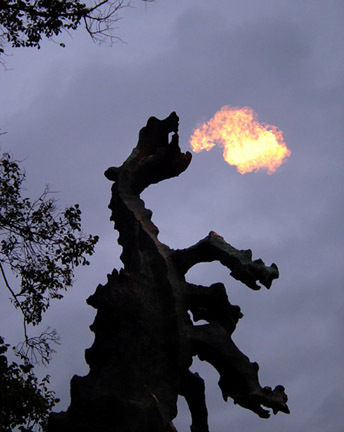 e
history of Krakow, I mentioned the legend which attributes the city’s
founding to Krakus, the mythical ruler who vanquished the Wawel Dragon.
The story goes that the Dragon devoured animals and virgins. Krakus is
said to have fed the dragon a calf in which he had stuffed a bag of
smoldering sulfur. The dragon ate it and exploded. This is one of
several interesting legends.
e
history of Krakow, I mentioned the legend which attributes the city’s
founding to Krakus, the mythical ruler who vanquished the Wawel Dragon.
The story goes that the Dragon devoured animals and virgins. Krakus is
said to have fed the dragon a calf in which he had stuffed a bag of
smoldering sulfur. The dragon ate it and exploded. This is one of
several interesting legends.
On the road up to the castle, over the hill on the right side, is
the alleged cave of the dragon complete with a life size dragon who will
breath fire on demand. The slope looked too
 steep
to climb down besides we didn’t have time. We also learned that there
was an entrance to the cave at the castle, but it involved walking down
spiral stairway of 135 steps. The stairway is said to be located in an
old well. Most of the cave is closed to visitors for safety reasons.
Obviously, we didn’t see the cave nor encounter the dragon.
steep
to climb down besides we didn’t have time. We also learned that there
was an entrance to the cave at the castle, but it involved walking down
spiral stairway of 135 steps. The stairway is said to be located in an
old well. Most of the cave is closed to visitors for safety reasons.
Obviously, we didn’t see the cave nor encounter the dragon.
As we walked up the sidewalk, we got a good loo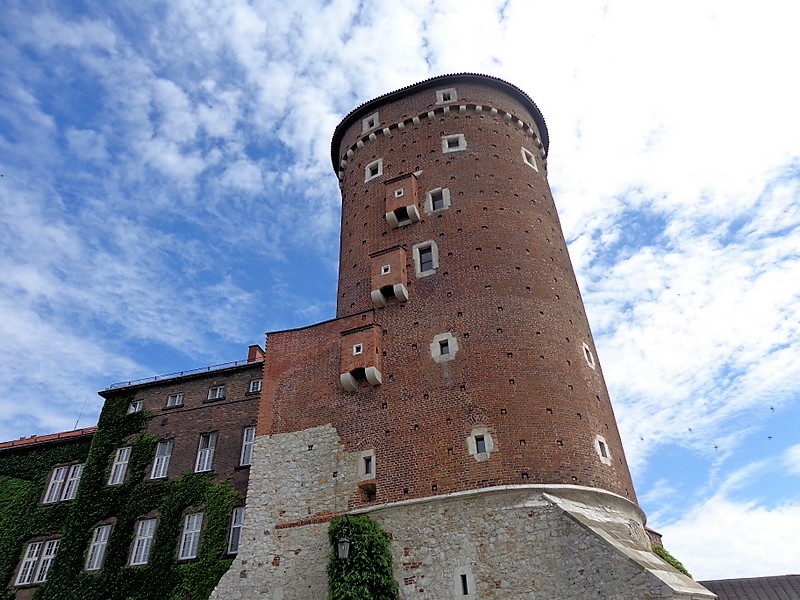 k
at the towers and walls of the outside of the castle. One of the towers
was particularly interesting. The little projections from the tower on
the photo are the toilets. It was advised not to walk to close to the
wall.
k
at the towers and walls of the outside of the castle. One of the towers
was particularly interesting. The little projections from the tower on
the photo are the toilets. It was advised not to walk to close to the
wall.
The Wawel Royal Castle was built by King Casimir III the Great. It
consists of a number of structures situated around the Italian
styled main courtyard. The castle, one of the largest in Poland,
represents nearly all European architectural styles of medieval,
renaissance and baroque periods. The Wawel Royal Castle and the Wawel
Hill is the most historically and culturally significant site in the
country.
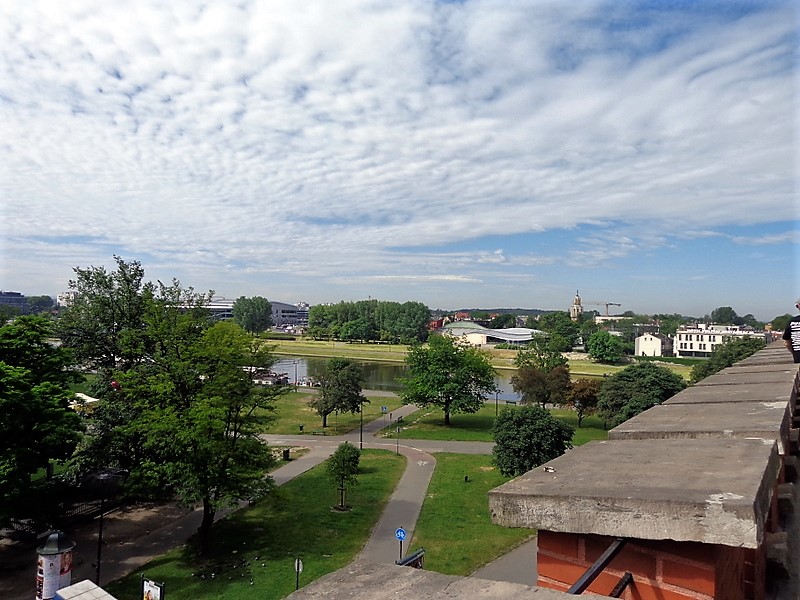 People
have lived on Wawel Hill at the site of the Castle as early as fifty
thousand years ago. The settlement was an active trade center, with
assorted crafts and local farming. When more people began to settle down
on the Wawel Hill and when trade became more efficient, the rulers of
Poland took up their residence at the Hill as well.
People
have lived on Wawel Hill at the site of the Castle as early as fifty
thousand years ago. The settlement was an active trade center, with
assorted crafts and local farming. When more people began to settle down
on the Wawel Hill and when trade became more efficient, the rulers of
Poland took up their residence at the Hill as well.
During the early 16th century King Sigismund I the Old and his
wife brought in the best native and foreign artists to refurbish the
castle into a splendid Renaissance palace.
In the fire of 1595, the northeast part
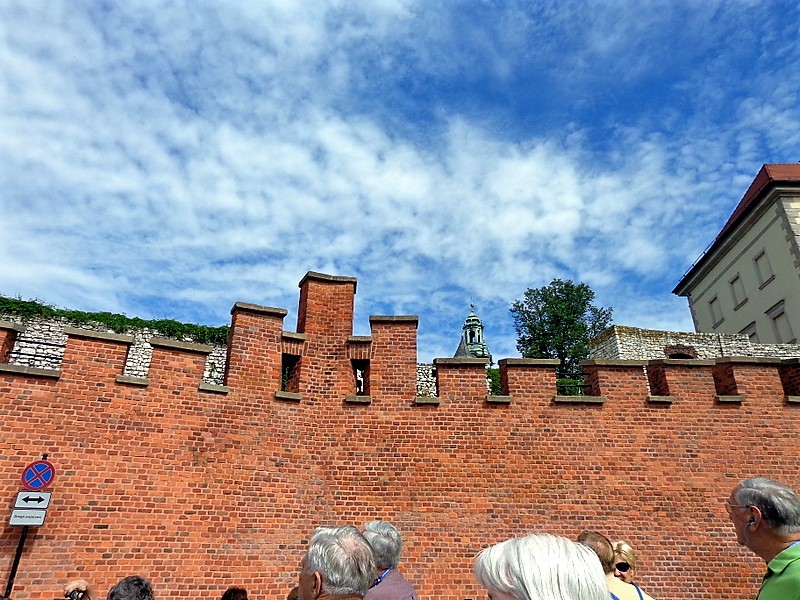 of
the castle burned down. King Sigismund III rebuilt it. In 1609 King
Sigismund moved the capital to Warsaw, and tough times for Wawel began.
Both the castle and other buildings were neglected despite the concerns
of local governors. The Swedish invasions of 1655–1657 and 1702
contributed to the further deterioration of the castle.
of
the castle burned down. King Sigismund III rebuilt it. In 1609 King
Sigismund moved the capital to Warsaw, and tough times for Wawel began.
Both the castle and other buildings were neglected despite the concerns
of local governors. The Swedish invasions of 1655–1657 and 1702
contributed to the further deterioration of the castle.
The Hill was occupied by the Prussian Army in 1794. After
the Third Partition of Poland (1795), Wawel, as an important defensive
point, was mostly demolished and the remaining part was modernized by
Austrians with defensive walls.
The interior of the castle was changed and some of the
buildings pulled down. In the second part of the 19th century the
Austrians
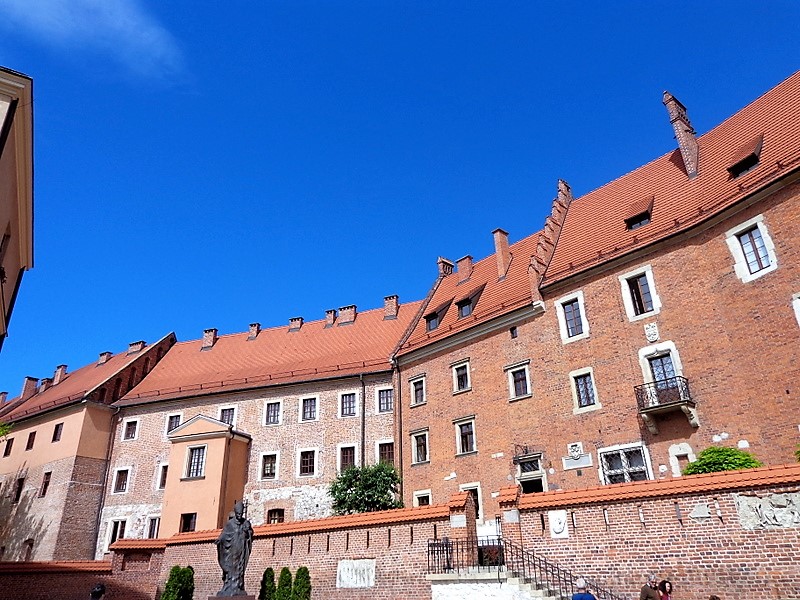 redesigned
the defensive walls making them a part of a stronghold. In 1905 the
emperor Franz Joseph I of Austria gave an order for Austrian troops to
leave Wawel. Polish restoration works began, with the discovery of the
Rotunda of Virgin Mary as well as other relics of the past.
redesigned
the defensive walls making them a part of a stronghold. In 1905 the
emperor Franz Joseph I of Austria gave an order for Austrian troops to
leave Wawel. Polish restoration works began, with the discovery of the
Rotunda of Virgin Mary as well as other relics of the past.
After World War I, the authorities of the newly independent Polish
Second Republic decided that Wawel Castle was to become a representative
building of the Polish state and would be used by the Governor and later
by the Preside nt
himself. In 1921 the Polish Parliament passed a resolution which gave
Wawel official status as the residence of the Polish President. In 1978,
it was declared a UNESCO World Heritage Site.
nt
himself. In 1921 the Polish Parliament passed a resolution which gave
Wawel official status as the residence of the Polish President. In 1978,
it was declared a UNESCO World Heritage Site.
We were given time on our own to explore the Castle and the
Cathedral. We didn’t have time to see any of the Castle except the
courtyard. Next we wandered over to the Cathedral.
THE ROYAL CATHEDRAL
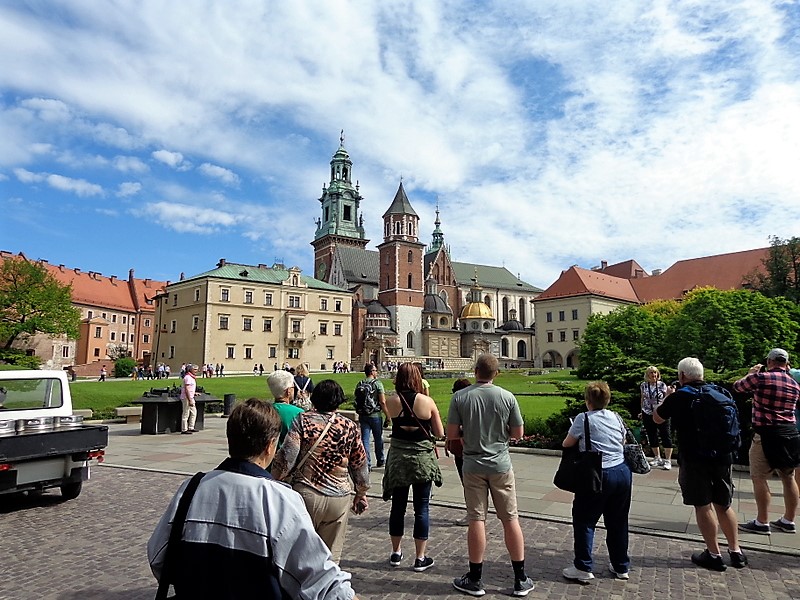 The
Royal Archcathedral of Saints Stanislaus and Wenceslaus is more than 900
years old. Traditionally it has served as coronation site of the Polish
monarchs as well as the Archdiocese of Kraków. The current, Gothic
cathedral, is the third edifice on this site: the first was constructed
and destroyed in the 11th century; the second one, constructed in the 1
The
Royal Archcathedral of Saints Stanislaus and Wenceslaus is more than 900
years old. Traditionally it has served as coronation site of the Polish
monarchs as well as the Archdiocese of Kraków. The current, Gothic
cathedral, is the third edifice on this site: the first was constructed
and destroyed in the 11th century; the second one, constructed in the 1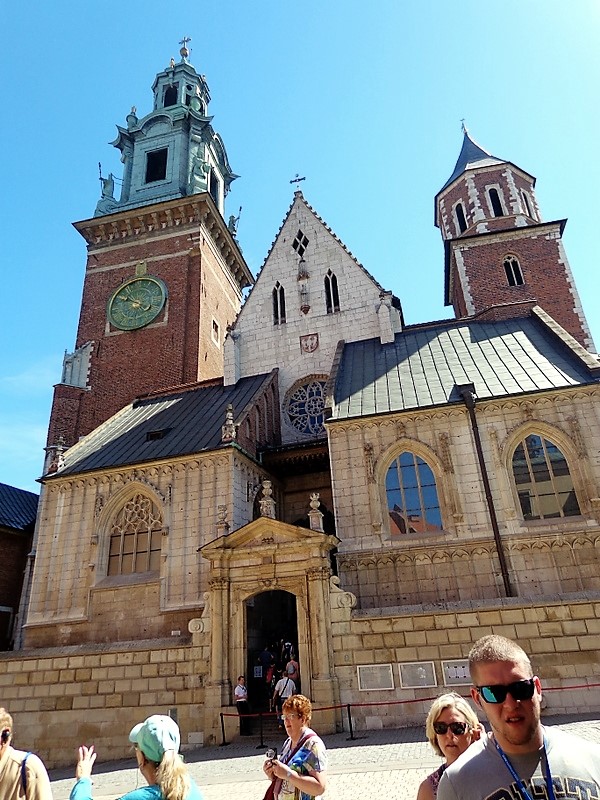 2th
century, was destroyed by a fire in 1305. The construction of the
current one began in the 14th century.
2th
century, was destroyed by a fire in 1305. The construction of the
current one began in the 14th century.
We only had a brief visit inside the cathedral.
 In
the center of the Wawel Cathedral's nave is the 1630 mausoleum of St.
Stanislav, Poland's saint patron, the 11th-century Krakow bishop
murdered by King Boleslav II (1058–1079). The martyr’s silver coffin is
adorned with 12 relief scenes from his life and posthumous miracles.
In
the center of the Wawel Cathedral's nave is the 1630 mausoleum of St.
Stanislav, Poland's saint patron, the 11th-century Krakow bishop
murdered by King Boleslav II (1058–1079). The martyr’s silver coffin is
adorned with 12 relief scenes from his life and posthumous miracles.
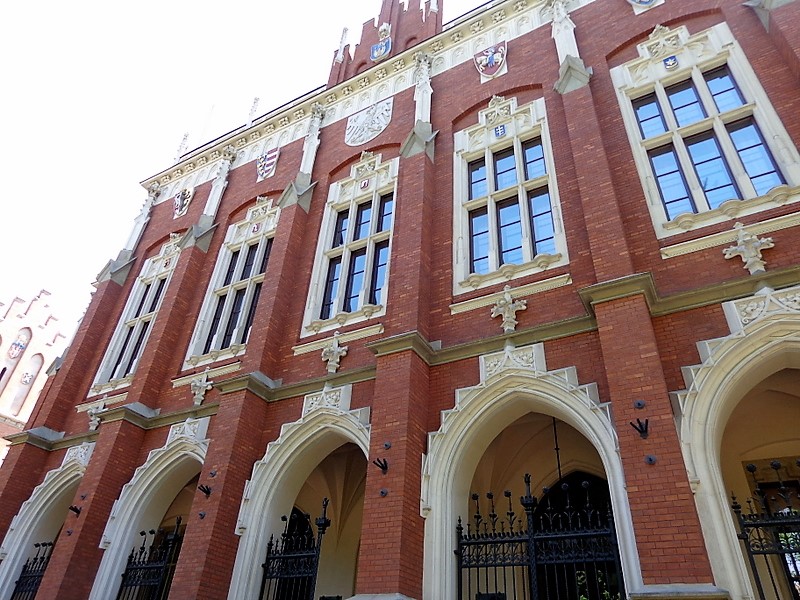 From
the castle, we walked past the Jagiellonian University, which
was founded in 1364 by Casimir III the Great. The University is the
oldest university in Poland, the second oldest university in central
Europe, and one of the oldest surviving universities in the world.
Notable alumni include mathematician and astronomer Nicholas Copernicus
whose statue is in front of one of the buildings. Other notable alumni
include Polish king John III Sobieski, Pope John Paul II, and Marta-
our tour manager
From
the castle, we walked past the Jagiellonian University, which
was founded in 1364 by Casimir III the Great. The University is the
oldest university in Poland, the second oldest university in central
Europe, and one of the oldest surviving universities in the world.
Notable alumni include mathematician and astronomer Nicholas Copernicus
whose statue is in front of one of the buildings. Other notable alumni
include Polish king John III Sobieski, Pope John Paul II, and Marta-
our tour manager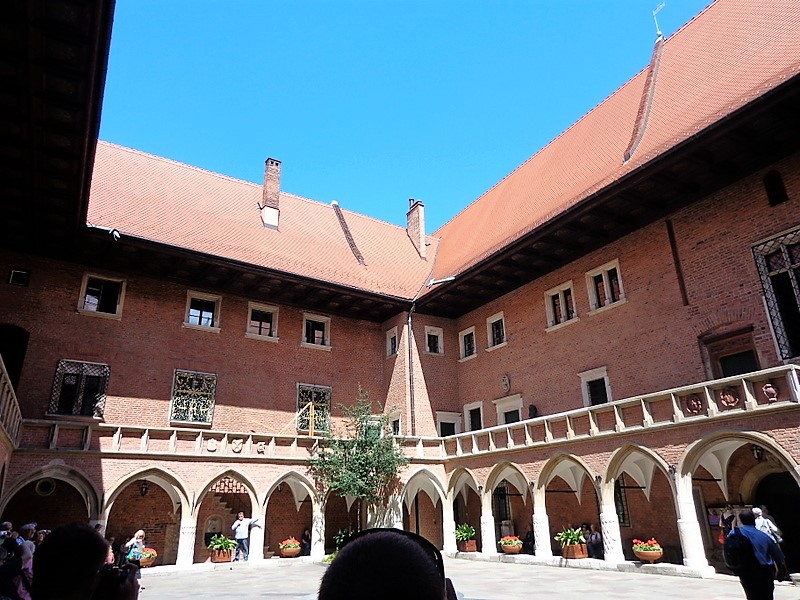 .
.
The university consists of fifteen schools — including the
humanities, law, the natural and social sciences, and medicine. The
university employs roughly 4,000 academics, and has more than 40,000
students who study in some 80 disciplines.
There are several other universities and colleges in Krakow.
CHURCH OF ST. ANDREW
We walked back to the market square where we were last night,
 stopping
at the Church of St. Andrew which was built in Romanesque style. It is
one of the oldest buildings in Kraków and one of the best-preserved
Romanesque buildings in Poland. It was the only church in Kraków to
withstand Mongol attack of 1241. Along the lower part of the broader
section of its façade are small openings that served as defensive
windows at a time when the church was a place of refuge from military
assaults.
stopping
at the Church of St. Andrew which was built in Romanesque style. It is
one of the oldest buildings in Kraków and one of the best-preserved
Romanesque buildings in Poland. It was the only church in Kraków to
withstand Mongol attack of 1241. Along the lower part of the broader
section of its façade are small openings that served as defensive
windows at a time when the church was a place of refuge from military
assaults.
From 1320 it was used by the Religious Order of the Poor Clares,
whose convent was built south of the church. The church building has
been renovated many times.
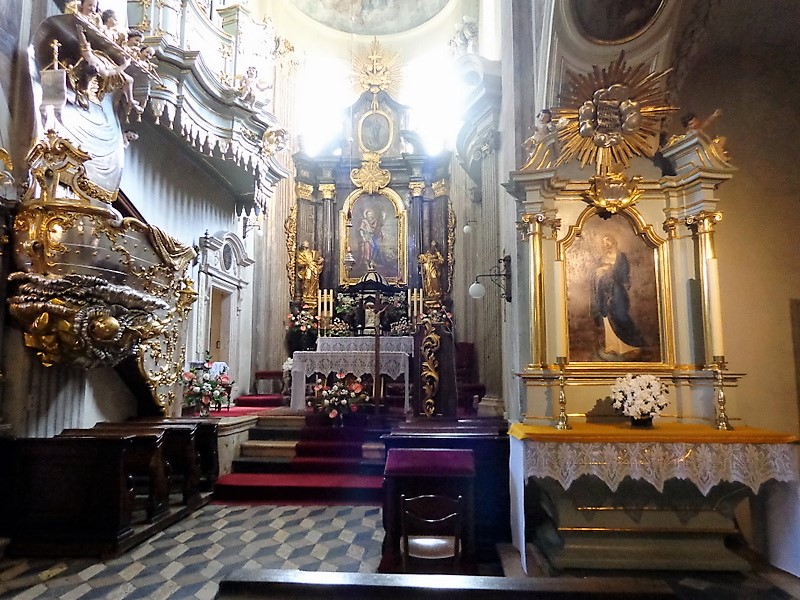
The baroque decoration of the interior, with rich stucco decoration
comes from the refurbishment that took place after 1700, while the
construction of the high altar came later. The pulpit is in the shape of
a boat. There was just a small vestibule with tall iron grilling that
prevented entrance into the church proper. I was able to take photo
through the grill work.
ST. MARY'S BASILICA
We walked back to the market square and went into St. Mary's Basilica – where Kathleen and I visited last night.
Every day around the noon there is a ceremony of opening the reredos
paneling over the altar. During the night it is closed. There are
paintings on the doors but at 11:45 a.m. the door panels are opened
revealing gold scenes of the life of Jesus. It had already been open
when we saw it last night.
went into St. Mary's Basilica – where Kathleen and I visited last night.
Every day around the noon there is a ceremony of opening the reredos
paneling over the altar. During the night it is closed. There are
paintings on the doors but at 11:45 a.m. the door panels are opened
revealing gold scenes of the life of Jesus. It had already been open
when we saw it last night.
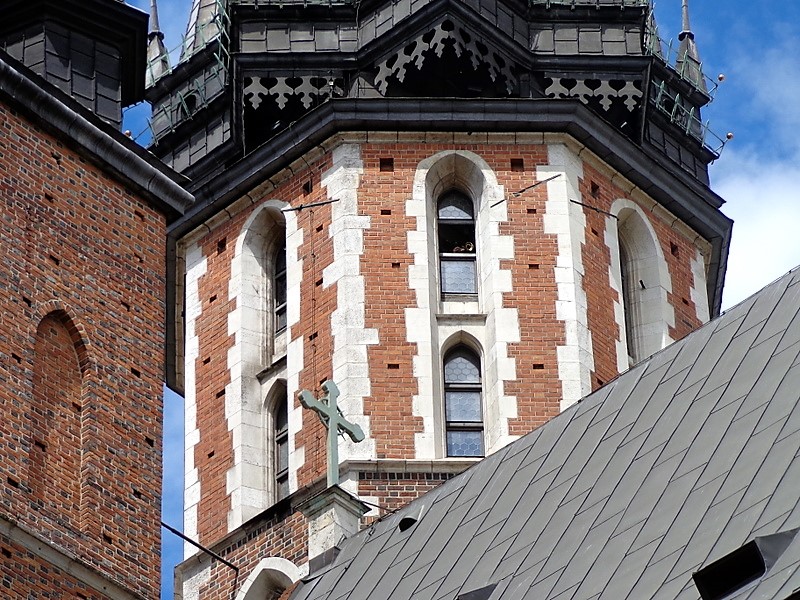
After we came out of the church, we hung around for a few minutes to
hear the 1:00 p.m. trumpet that we heard last night.
The tour of the city ended, and we were free to have lunch on our
own. We went a nice side walk café, Szara, and sat with a lady and her
grown daughter from Alberta, Canada who are on the tour. I had a shrimp
salad and Kathleen had a salmon salad. Most of the other people on the
tour, except us, went on a tour of the Salt Mines. We had been told that
it involved a lot of walking and was all underground. It an extra pay
trip, and we decided a long time ago that we didn't want to do it as it
involved too much walking and we are not into underground exploration.
After lunch we walked a few blocks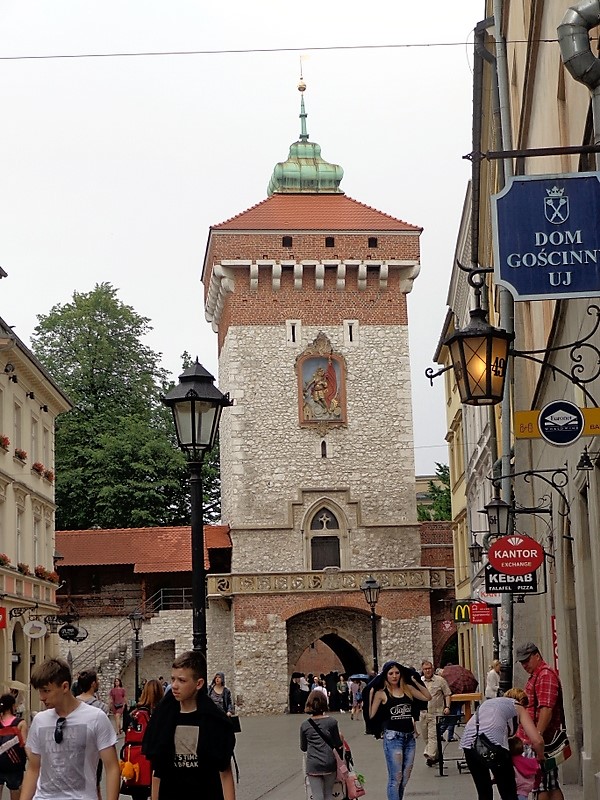 to
the St. Florian Gate which led to the old barbican. I have a model of
both the gate and the barbican to build. The tower, first mentioned in
1307, had been built as part of a protective rampart around Kraków after
the Tatar attack of 1241 which destroyed most of the city. The permit
for the construction of new city defenses featuring stone watchtowers,
fortified gates and a moat was issued in 1285. The gate named after St.
Florian, became the main entryway to the Old Town. It was connected by a
long bridge to the circular barbican erected of brick on the other side
of the moat. According to records, by 1473 there were 17 towers
defending the city; a century later, there were 33. At the height of its
existence, the wall featured 47 watchtowers and eight gates. The Gate
tower is 110 inches tall. The Florian Gate is the only city gate, of the
original eight built in the Middle Ages, that was not dismantled during
the 19th-century modernizat
to
the St. Florian Gate which led to the old barbican. I have a model of
both the gate and the barbican to build. The tower, first mentioned in
1307, had been built as part of a protective rampart around Kraków after
the Tatar attack of 1241 which destroyed most of the city. The permit
for the construction of new city defenses featuring stone watchtowers,
fortified gates and a moat was issued in 1285. The gate named after St.
Florian, became the main entryway to the Old Town. It was connected by a
long bridge to the circular barbican erected of brick on the other side
of the moat. According to records, by 1473 there were 17 towers
defending the city; a century later, there were 33. At the height of its
existence, the wall featured 47 watchtowers and eight gates. The Gate
tower is 110 inches tall. The Florian Gate is the only city gate, of the
original eight built in the Middle Ages, that was not dismantled during
the 19th-century modernizat ion
of Kraków. The adjoining city walls and two additional, smaller towers
had been preserved and today host street displays of amateur art
available for purchase.
ion
of Kraków. The adjoining city walls and two additional, smaller towers
had been preserved and today host street displays of amateur art
available for purchase.
The south face of St. Florian's Gate is adorned with an
18th-century bas-relief of St. Florian. The tower's north face bears a
stone eagle that was carved in 1882. Going through the gate, barbican
comes into view. Of course, there is no moat to cross and the barbican
was not open to the public, but we could see through the gate.
The Gothic style barbican, built around 1498, is one of only three
such fortified outposts still surviving in Europe, an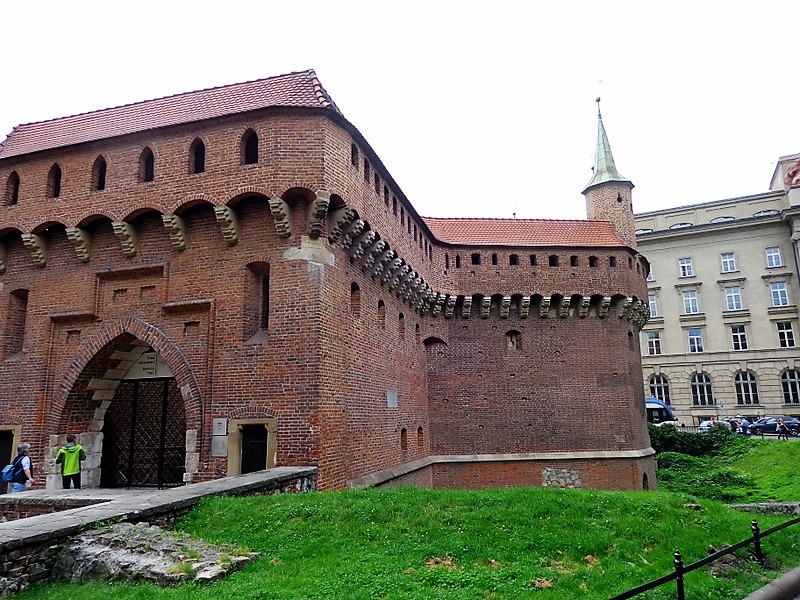 d
the best preserved. We had visited the barbican in Warsaw. The Krakow
barbican is a moated cylindrical brick structure with inner courtyard 80
feet in diameter, and seven turrets. Its 10 foot-thick walls hold 130
embrasures, whose purpose is to allow weapons to be fired out from the
fortification while the firer city walls by a covered passageway that
led through a Florian’s gate and ser
d
the best preserved. We had visited the barbican in Warsaw. The Krakow
barbican is a moated cylindrical brick structure with inner courtyard 80
feet in diameter, and seven turrets. Its 10 foot-thick walls hold 130
embrasures, whose purpose is to allow weapons to be fired out from the
fortification while the firer city walls by a covered passageway that
led through a Florian’s gate and ser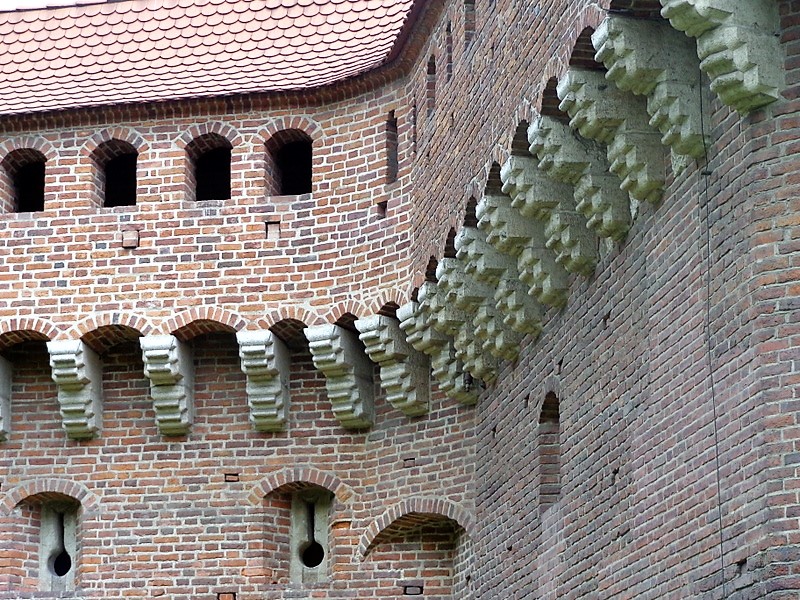 ved
as a checkpoint for all who entered the city.
ved
as a checkpoint for all who entered the city.
It had been very hot and sunny today, but during lunch it got cloudy
and a little windy. It rained a little when we went to the barbican.
It was after 2:00 and we walked back to our hotel. We have walked over
5 miles today according to our pedometer.
Since most of the group went to the salt mines where they also
had dinner, we had reservations at the restaurant, Pod Baranem, about a
10 minute walk from our hotel, but it was raining so we called a cab.
It was a delightful place with 4 or 5 d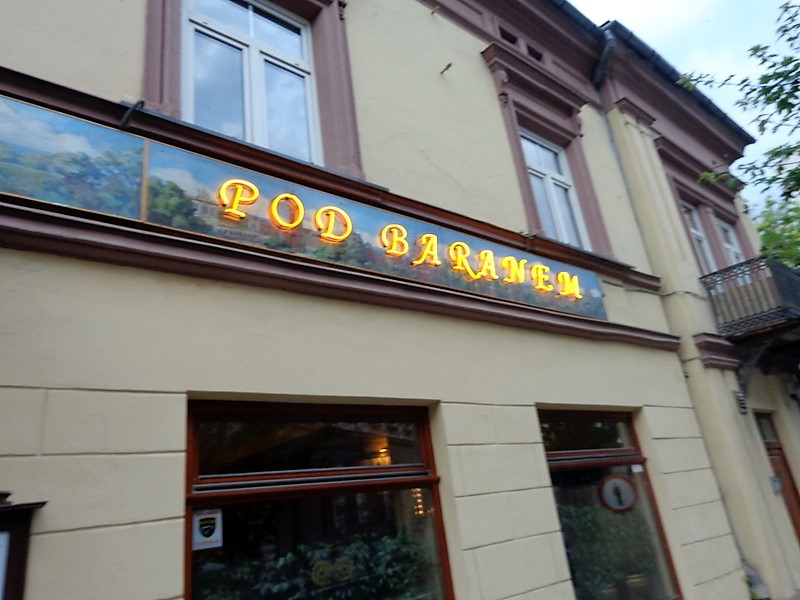 ining
rooms. Kathleen had cold beet soup (her new love) and I had fois
gras for starters. We both had the same meal- lamb chops, fried new
potatoes and beets. For dessert, we shared a delicious raspberry cake.
Everything was beautifully served and was exceptionally delicious.
ining
rooms. Kathleen had cold beet soup (her new love) and I had fois
gras for starters. We both had the same meal- lamb chops, fried new
potatoes and beets. For dessert, we shared a delicious raspberry cake.
Everything was beautifully served and was exceptionally delicious.
Our coach leaves Kraków at 7:30 tomorrow morning and we have to have
our bags out at 6:30.
Day 15 coming soon

 e
history of Krakow, I mentioned the legend which attributes the city’s
founding to Krakus, the mythical ruler who vanquished the Wawel Dragon.
The story goes that the Dragon devoured animals and virgins. Krakus is
said to have fed the dragon a calf in which he had stuffed a bag of
smoldering sulfur. The dragon ate it and exploded. This is one of
several interesting legends.
e
history of Krakow, I mentioned the legend which attributes the city’s
founding to Krakus, the mythical ruler who vanquished the Wawel Dragon.
The story goes that the Dragon devoured animals and virgins. Krakus is
said to have fed the dragon a calf in which he had stuffed a bag of
smoldering sulfur. The dragon ate it and exploded. This is one of
several interesting legends.  In
the center of the Wawel Cathedral's nave is the 1630 mausoleum of St.
Stanislav, Poland's saint patron, the 11th-century Krakow bishop
murdered by King Boleslav II (1058–1079). The martyr’s silver coffin is
adorned with 12 relief scenes from his life and posthumous miracles.
In
the center of the Wawel Cathedral's nave is the 1630 mausoleum of St.
Stanislav, Poland's saint patron, the 11th-century Krakow bishop
murdered by King Boleslav II (1058–1079). The martyr’s silver coffin is
adorned with 12 relief scenes from his life and posthumous miracles.  went into St. Mary's Basilica – where Kathleen and I visited last night.
Every day around the noon there is a ceremony of opening the reredos
paneling over the altar. During the night it is closed. There are
paintings on the doors but at 11:45 a.m. the door panels are opened
revealing gold scenes of the life of Jesus. It had already been open
when we saw it last night.
went into St. Mary's Basilica – where Kathleen and I visited last night.
Every day around the noon there is a ceremony of opening the reredos
paneling over the altar. During the night it is closed. There are
paintings on the doors but at 11:45 a.m. the door panels are opened
revealing gold scenes of the life of Jesus. It had already been open
when we saw it last night.